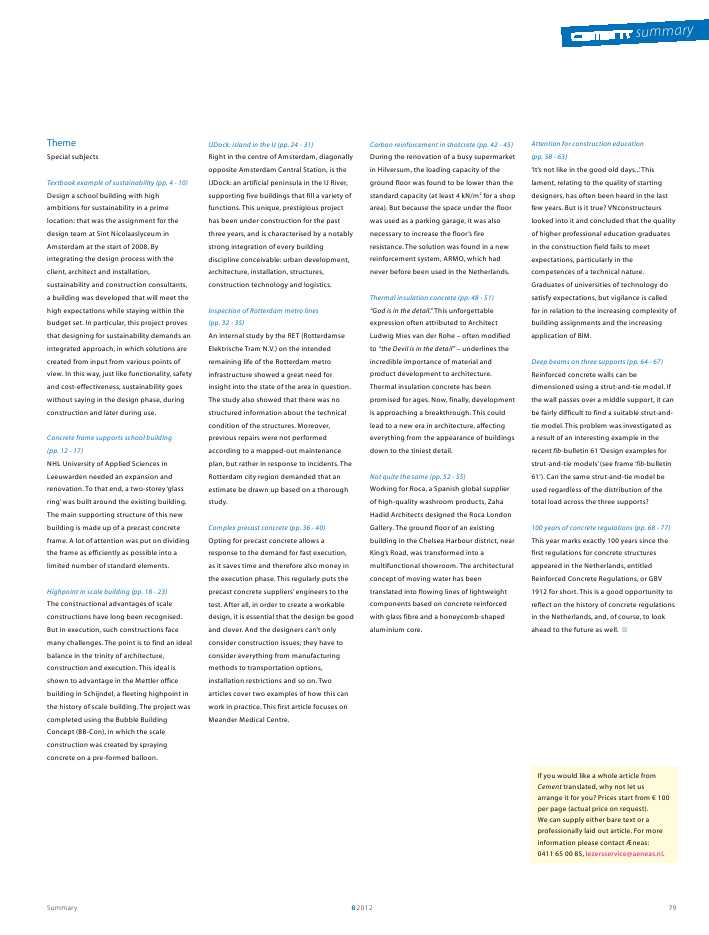
Summary 82012 79ThemeSpecial subjectsTextbook example of sustainability (pp. 4 - 10)Design a school building with highambitions for sustainability in a primelocation: that was the assignment for thedesign team at Sint Nicolaaslyceum inAmsterdam at the start of 2008. Byintegrating the design process with theclient, architect and installation,sustainability and construction consultants,a building was developed that will meet thehigh expectations while staying within thebudget set. In particular, this project provesthat designing for sustainability demands anintegrated approach, in which solutions arecreated from input from various points ofview. In this way, just like functionality, safetyand cost-effectiveness, sustainability goeswithout saying in the design phase, duringconstruction and later during use.Concrete frame supports school building(pp. 12 - 17)NHL University of Applied Sciences inLeeuwarden needed an expansion andrenovation. To that end, a two-storey`glassring'was built around the existing building.The main supporting structure of this newbuilding is made up of a precast concreteframe. A lot of attention was put on dividingthe frame as efficiently as possible into alimited number of standard elements.Highpoint in scale building (pp. 18 - 23)The constructional advantages of scaleconstructions have long been recognised.But in execution, such constructions facemany challenges. The point is to find an idealbalance in the trinity of architecture,construction and execution. This ideal isshown to advantage in the Mettler officebuilding in Schijndel, a fleeting highpoint inthe history of scale building. The project wascompleted using the Bubble BuildingConcept (BB-Con), in which the scaleconstruction was created by sprayingconcrete on a pre-formed balloon.IJDock: island in the IJ (pp. 24 - 31)Right in the centre of Amsterdam, diagonallyopposite Amsterdam Central Station, is theIJDock: an artificial peninsula in the IJ River,supporting five buildings that fill a variety offunctions. This unique, prestigious projecthas been under construction for the pastthree years, and is characterised by a notablystrong integration of every buildingdiscipline conceivable: urban development,architecture, installation, structures,construction technology and logistics.Inspection of Rotterdam metro lines(pp. 32 - 35)An internal study by the RET (RotterdamseElektrische Tram N.V.) on the intendedremaining life of the Rotterdam metroinfrastructure showed a great need forinsight into the state of the area in question.The study also showed that there was nostructured information about the technicalcondition of the structures. Moreover,previous repairs were not performedaccording to a mapped-out maintenanceplan, but rather in response to incidents. TheRotterdam city region demanded that anestimate be drawn up based on a thoroughstudy.Complex precast concrete (pp. 36 - 40)Opting for precast concrete allows aresponse to the demand for fast execution,as it saves time and therefore also money inthe execution phase. This regularly puts theprecast concrete suppliers'engineers to thetest. After all, in order to create a workabledesign, it is essential that the design be goodand clever. And the designers can't onlyconsider construction issues; they have toconsider everything from manufacturingmethods to transportation options,installation restrictions and so on. Twoarticles cover two examples of how this canwork in practice. This first article focuses onMeander Medical Centre.Carbon reinforcement in shotcrete (pp. 42 - 45)During the renovation of a busy supermarketin Hilversum, the loading capacity of theground floor was found to be lower than thestandard capacity (at least 4 kN/m2for a shoparea). But because the space under the floorwas used as a parking garage, it was alsonecessary to increase the floor's fireresistance. The solution was found in a newreinforcement system, ARMO, which hadnever before been used in the Netherlands.Thermal insulation concrete (pp. 48 - 51)"God is in the detail." This unforgettableexpression often attributed to ArchitectLudwig Mies van der Rohe ? often modifiedto "the Devil is in the detail" ? underlines theincredible importance of material andproduct development to architecture.Thermal insulation concrete has beenpromised for ages. Now, finally, developmentis approaching a breakthrough. This couldlead to a new era in architecture, affectingeverything from the appearance of buildingsdown to the tiniest detail.Not quite the same (pp. 52 - 55)Working for Roca, a Spanish global supplierof high-quality washroom products, ZahaHadid Architects designed the Roca LondonGallery. The ground floor of an existingbuilding in the Chelsea Harbour district, nearKing's Road, was transformed into amultifunctional showroom. The architecturalconcept of moving water has beentranslated into flowing lines of lightweightcomponents based on concrete reinforcedwith glass fibre and a honeycomb-shapedaluminium core.Attention for construction education(pp. 58 - 63)`It's not like in the good old days...'Thislament, relating to the quality of startingdesigners, has often been heard in the lastfew years. But is it true? VNconstructeurslooked into it and concluded that the qualityof higher professional education graduatesin the construction field fails to meetexpectations, particularly in thecompetences of a technical nature.Graduates of universities of technology dosatisfy expectations, but vigilance is calledfor in relation to the increasing complexity ofbuilding assignments and the increasingapplication of BIM.Deep beams on three supports (pp. 64 - 67)Reinforced concrete walls can bedimensioned using a strut-and-tie model. Ifthe wall passes over a middle support, it canbe fairly difficult to find a suitable strut-and-tie model. This problem was investigated asa result of an interesting example in therecent fib-bulletin 61`Design examples forstrut-and-tie models'(see frame`fib-bulletin61'). Can the same strut-and-tie model beused regardless of the distribution of thetotal load across the three supports?100 years of concrete regulations (pp. 68 - 77)This year marks exactly 100 years since thefirst regulations for concrete structuresappeared in the Netherlands, entitledReinforced Concrete Regulations, or GBV1912 for short. This is a good opportunity toreflect on the history of concrete regulationsin the Netherlands, and, of course, to lookahead to the future as well. If you would like a whole article fromCement translated, why not let usarrange it for you? Prices start from 100per page (actual price on request).We can supply either bare text or aprofessionally laid out article. For moreinformation please contact ?neas:0411 65 00 85, lezersservice@aeneas.nl.summary

Reacties